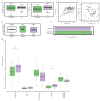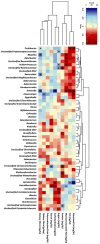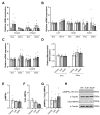Dietary Fibre Modulates Gut Microbiota in Late Pregnancy Without Altering SCFA Levels, and Propionate Treatement Has No Effect on Placental Explant Function
- PMID: 40218992
- PMCID: PMC11990268
- DOI: 10.3390/nu17071234
Dietary Fibre Modulates Gut Microbiota in Late Pregnancy Without Altering SCFA Levels, and Propionate Treatement Has No Effect on Placental Explant Function
Abstract
Background/Objectives: Dietary fibre promotes health, partly by mediating gut microbiota and short-chain fatty acid (SCFA) production. Pregnancy alters the relationship between dietary composition and the gut microbiota, and it is unclear if fibre intake during late pregnancy alters the abundance of SCFA bacteria and circulating SFCA concentrations. The aim of this study was to determine the impact of dietary fibre on faecal microbiome composition and circulating concentrations of SCFA acetate, butyrate, and propionate in late pregnancy. We also aimed to assess the impact of propionate treatment on placental function using cultured placental explants. Methods: 16S rRNA gene amplicon sequencing was performed on faecal DNA collected at 28 weeks of gestation from participants enrolled in the SPRING cohort study consuming a low or adequate fibre diet. Circualting SCFA were assessed. Placental explants were treated with sodium propionate. Results: Fibre intake did not impact microbial diversity or richness but did impact the abundance of specific bacterial genera. Pregnant participants with low-fibre diets had a greater abundance of Bacteroides and Sutterella, and dietary fibre intake (mg/day) negatively correlated with genera, including Sutterella, Bilophila, and Bacteroides. SCFA concentrations did not differ between groups but circulating concentrations of acetate, propionate, and butyrate did correlate with the abundance of key bacterial genera. Propionate treatment of placental explants did not alter mRNA expression of fatty acid receptors, antioxidants, or markers of apoptosis, nor did it impact pAMPK levels. Conclusions: This study demonstrates that the impact of dietary fibre on SCFA concentrations in pregnant women is modest, although this relationship may be difficult to discern given that other dietary factors differed between groups. Furthermore, this study demonstrates that propionate does not impact key pathways in placental tissue, suggesting that previous associations between this SCFA and placental dysfunction may be due to other maternal factors.
Keywords: AMPK; SPRING; microbiome.
Conflict of interest statement
The authors declare no conflicts of interest.
Figures




Similar articles
-
Can the gastrointestinal microbiota be modulated by dietary fibre to treat obesity?Ir J Med Sci. 2018 May;187(2):393-402. doi: 10.1007/s11845-017-1686-9. Epub 2017 Oct 16. Ir J Med Sci. 2018. PMID: 29038988 Review.
-
Butyrate, but not propionate, reverses maternal diet-induced neurocognitive deficits in offspring.Pharmacol Res. 2020 Oct;160:105082. doi: 10.1016/j.phrs.2020.105082. Epub 2020 Jul 15. Pharmacol Res. 2020. PMID: 32679183
-
Low dietary fiber intake increases Collinsella abundance in the gut microbiota of overweight and obese pregnant women.Gut Microbes. 2018;9(3):189-201. doi: 10.1080/19490976.2017.1406584. Epub 2018 Mar 13. Gut Microbes. 2018. PMID: 29144833 Free PMC article.
-
Effects of dietary fibre and protein content on intestinal fibre degradation, short-chain fatty acid and microbiota composition in a high-fat fructose-rich diet induced obese Göttingen Minipig model.Food Funct. 2020 Dec 1;11(12):10758-10773. doi: 10.1039/d0fo02252g. Epub 2020 Nov 24. Food Funct. 2020. PMID: 33231591
-
The Role of Dietary Fibre in Modulating Gut Microbiota Dysbiosis in Patients with Type 2 Diabetes: A Systematic Review and Meta-Analysis of Randomised Controlled Trials.Nutrients. 2020 Oct 23;12(11):3239. doi: 10.3390/nu12113239. Nutrients. 2020. PMID: 33113929 Free PMC article.
References
MeSH terms
Substances
Grants and funding
LinkOut - more resources
Full Text Sources
Medical

